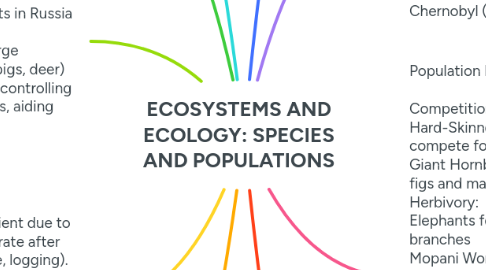ECOSYSTEMS AND ECOLOGY: SPECIES AND POPULATIONS
作者:Joaquin pane

1. Biotic factors refer to the living components within an ecosystem that influence the organisms and environment. These factors are integral in shaping the interactions and relationships within an ecosystem.
2. Abiotic Factors Climate (temperature, humidity, precipitation) Soil composition Water availability Sunlight Fire
3. Example Species Niche: Siberian Tiger Habitat: Boreal forests in Russia D iet: Predominantly large mammals (e.g., wild pigs, deer) Role: Apex predator, controlling herbivore populations, aiding forest regeneration
4. Resilience of Forests Forests are more resilient due to their ability to regenerate after disturbances (e.g., fire, logging). Diverse species interactions (e.g., mutualism, competition) enhance recovery and stability. Large seed banks and adaptive strategies in plants and animals support regrowth. Complex food webs ensure functional redundancy, aiding in ecosystem recovery.
5. An ecosystem is a community of living organisms (plants, animals, and microorganisms) in conjunction with the nonliving components of their environment (such as air, water, and mineral soil), interacting as a system. These biotic and abiotic components are regarded as linked together through nutrient cycles and energy flows.
6. Siberian Tiger Bald Eagle Wild Pig Salmon Hard-Skinned Salamander Lion-Tailed Macaque Giant Hornbill Elephants Mopani Worms Wild Dogs Lemurs Fossa European Roe Deer Przewalski Horses Wolves Gray Mouse Lemur
7. Boreal Forest (Northern Hemisphere) Western Alaska Pacific Northwest (USA) Western Ghats (India) Miombo Forest (Africa) Madagascar Chernobyl (Ukraine)
8. Population Interactions Competition: Hard-Skinned Salamander males compete for females Giant Hornbill males compete for figs and mates Herbivory: Elephants feed on leaves and branches Mopani Worms feed on tree leaves Predation: Siberian Tiger preys on wild pigs Fossa preys on lemurs Parasitism: Potential parasites on any of the animal populations, e.g., ticks on deer Mutualism: Lion-Tailed Macaque spreads tree seeds through droppings Giant Hornbill spreads seeds over large areas
9. Limiting Factores BorealForest: Extreme cold, short. growing season, limited prey. WesternAlaska: Seasonal food availability, freezing rivers. PacificNorthwest: Fire risk. Competición por los recursos. WesternGhats: Hábitat fragmentation, food availability. MiomboForest: Water scarcity. food availability durante la dry season. Madagascar:Habitat destruction, Limitada fuente de alimento. Chernobyl:Radiación, humano absence, limited initial biodiversity.


